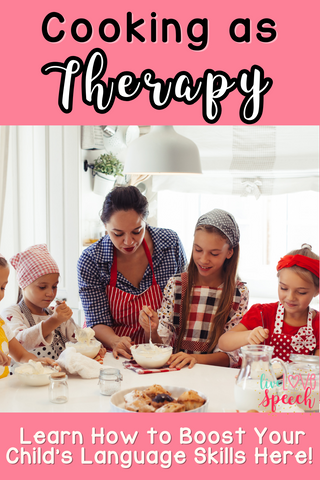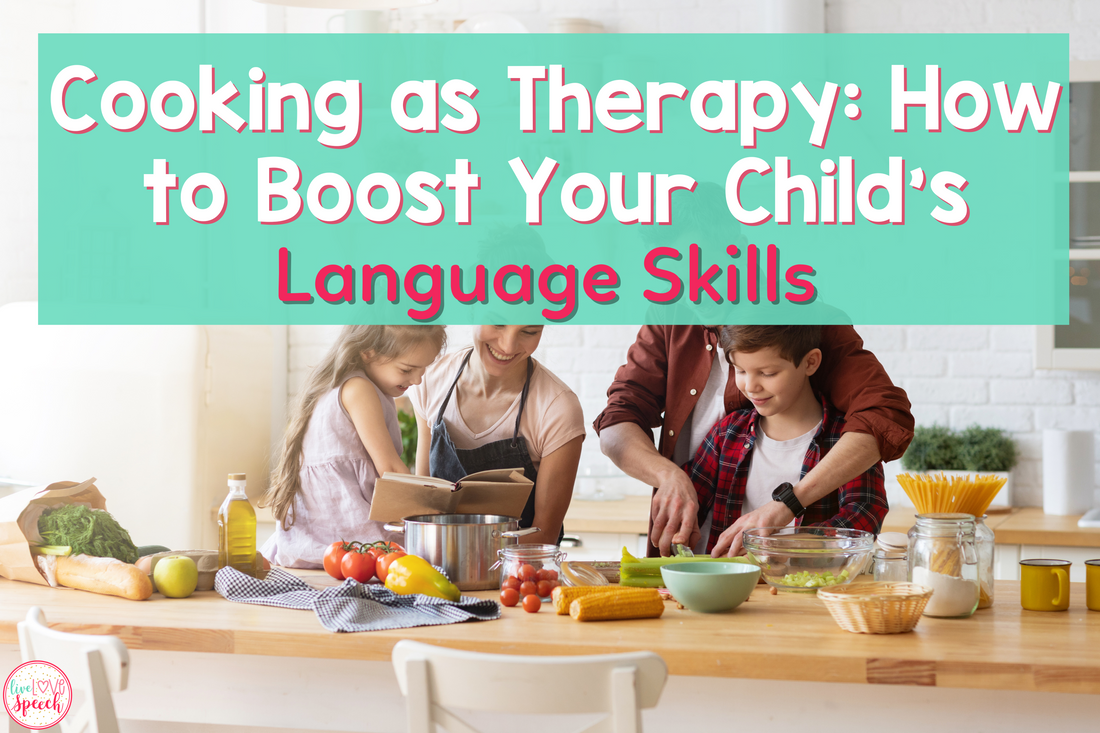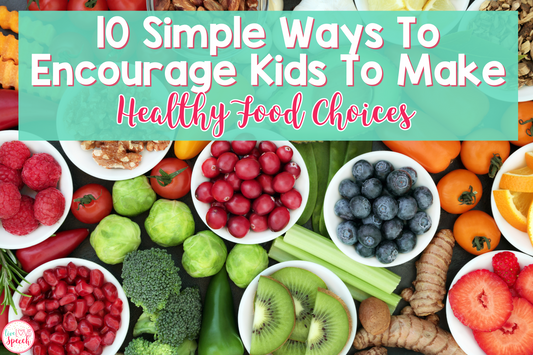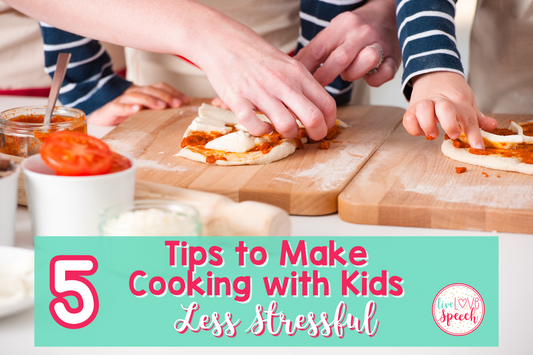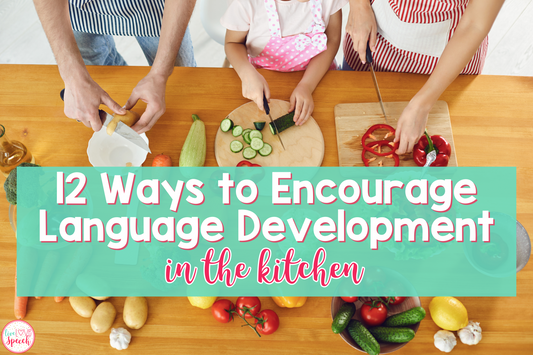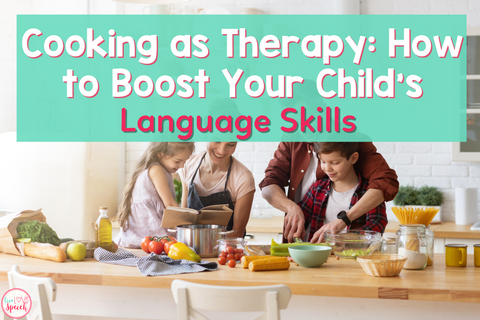
Over the years, I've come to realize that cooking isn't just about whipping up delicious and, of course, adorable snacks, desserts, and meals. It's become a therapeutic journey for me. I've watched it not only nourish my body but also my soul. It's funny how much cooking can be like therapy – it's a chance for me to express my creativity, engage my senses, and find a moment of peace in my hustle and bustle. As a parent, bringing cooking into a normal routine with Landon has opened up a world of benefits beyond simply satisfying hunger. Here, I want to discuss how beneficial cooking is and 5 ways to use cooking as therapy to boost Language Skills.
Cooking at Home
Cooking at home with your kids is incredibly important—it's a time to learn and bond together. I love every minute I get to spend with Landon in the kitchen. We share fun stories, create memories, and simply enjoy each other's company. Unlike playing with toys or running around, cooking offers a unique opportunity to engage in an activity that you might enjoy as well, deepening your bond in a different way. It's a more relaxed and informal setting for learning as well and allows them to develop practical skills. Plus, it teaches them valuable life skills they'll carry with them forever. I know that Landon will forever remember these moments in the kitchen!!
Cooking Preparations
Before you start your therapeutic cooking journey with the kids, let's get prepped! Make sure you've got all your ingredients on hand and your kitchen workspace is tidy and ready to roll. If you need some guidance on how to get started, I've got a blog post packed with tips to help you dive into the world of cooking with your little ones. Click here to find out more! Once you're prepped and ready, it's time to find that perfect recipe. Whether you're in the mood for a cozy comfort dish or a sweet treat, the options are endless. And hey, why not check out these simple, fun recipes to get you started? Cooking and Craft Recipe Pack. There are 10 recipes for each season (fall, winter, spring, & summer). Additionally, it includes 10 recipes that can be used anytime throughout the year.
Activities to Boost Language Skills
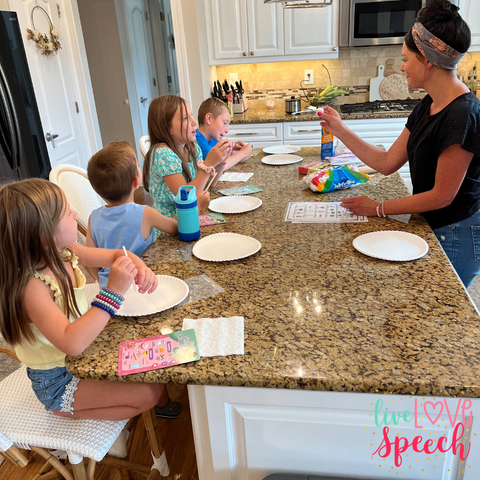
1. Narrate the Process
While cooking together, describe each step aloud, using rich, descriptive language to explain what you're doing, what ingredients you're using, and how they look, smell, and feel. Your kids will love this, for instance, when carefully slicing those juice red tomatoes, talk about how they shine and smell so fresh. The smell fills the air with a tangy sweetness. Similarly, while mincing the garlic, do you feel the firm texture of the cloves, or are you inhaling the pungent scent. Incorporate these sensory experiences to enrich your vocabulary and comprehension of cooking-related terms. This descriptive language also helps your kids get better at talking and understanding things. And noticing all the cool stuff about the ingredients—like their colors, textures, and smells—makes their cooking experience even more fun and interesting!
2. Ask Open-Ended Questions
Encourage conversation by asking open-ended questions about the cooking process. Instead of yes/no questions, because sometimes with those questions it's hard to get a response! Ask things like "What do you think will happen if we mix these ingredients?" or "Can you describe the taste/smell/texture of this ingredient?" This fosters expressive language and critical thinking. More examples would be, "How do you think adding more herbs will change the flavor of our dish?" or "What do you notice about the way the dough feels as we knead it?" These questions not only spark curiosity but also encourage your child to think deeply about their observations and ideas, enhancing their communication skills and ability to analyze and problem-solve. Discussing the cooking process is also important and can serve as a metaphor for navigating challenges and making decisions in other areas of life, helping children generalize these skills beyond the kitchen So, keep conversation flowing as you explore the world of cooking as therapy together!
3. Create a "Recipe Talk" Routine:

Before starting a recipe, sit down together and read through it. Discuss the ingredients needed, the order of steps, and what tools are required. Encourage your child to ask questions and predict what might happen next. For instance, you might say, "We need flour, sugar, and eggs for this cake. What do you think we'll use the eggs for?" or "Why do you think the recipe asks us to mix the dry ingredients before adding the wet ones?" This interactive discussion reinforces sequencing skills and comprehension while also sparking curiosity and critical thinking.
This routine serves as an excellent way to scaffold learning and promote independence. By involving children in the planning and preparation process, it will help them develop organizational skills and increase their understanding of cause and effect. Additionally, discussing the recipe allows children to practice following directions and making predictions, which are essential skills for academic success and everyday life.
4. Introduce New Vocabulary:
Focus on introducing new cooking-related vocabulary during the activity. Label utensils, ingredients, and actions. For instance, explain the difference between "chopping" and "mixing" or the names of various vegetables and spices. Reinforce these words during the cooking process by saying things like, "Now we're going to chop the carrots into small pieces. Chopping means to cut something into small bits like this," or "Let's mix the batter until all the ingredients are well combined. Mixing means to blend everything together evenly, like stirring this soup." By incorporating these vocabulary-building moments into your cooking sessions, you're not only making delicious meals but also expanding your child's language skills in a fun and interactive way.
Introducing new vocabulary in this manner is highly effective for language development. By connecting words to real-world objects and actions, children can better understand and remember their meanings. For example, discussing the difference between "slicing" and "dicing" while preparing ingredients helps reinforce the concepts of size and shape. Moreover, labeling utensils and ingredients provides children with the language they need to communicate effectively in the kitchen and in other environments. By consistently reinforcing these words throughout the cooking process, it will support vocabulary acquisition and promote language comprehension in a meaningful context.

5. Turn Cooking into a Story
One of my Favorites!!! Encourage storytelling during cooking by creating a narrative about the recipe. Talk about where the ingredients come from, their history, or personal experiences related to the dish. For example, you could say, "These tomatoes we're using come from a farm nearby where they're grown under the warm sun. They're like little bursts of sunshine in our dish!" or "Did you know that the recipe for this soup has been passed down in our family for generations? It's a special dish that brings back memories of cooking with Grandma." By weaving stories into the cooking process, you not only make it more engaging but also promote narrative skills, imagination, and language organization in your child. Plus, who doesn't like to make up fun stories!
Turning cooking into a story offers numerous benefits for language development. By incorporating personal experiences and cultural references into the narrative, it can help children connect with the activity on a deeper level. They might relate it to something in their own life. Moreover, storytelling promotes narrative skills, including sequencing events, describing characters and settings, and understanding cause and effect. For children who struggle with expressing themselves verbally or organizing their thoughts, cooking can serve as a creative outlet for storytelling and self-expression.
By blending therapy with cooking, you will discover AMAZING ways to assist kids/students with their language skills, especially in speech therapy. Cooking is a great avenue for learning where you are able chat about each step, ask questions, learn new words, and even share stories. It's not just about making food—it's also about cooking up language skills, making cooking both fun and effective!
Visual Recipe Cards
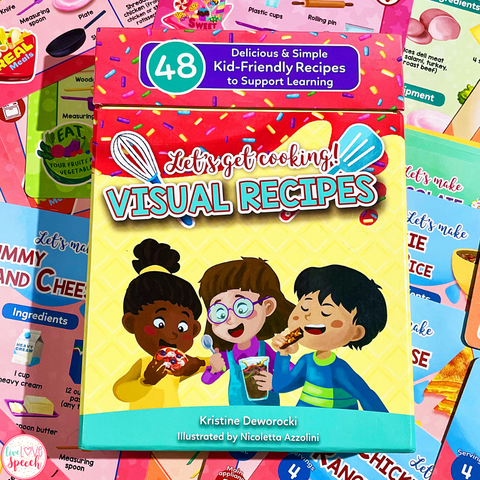

Visual Recipe Cards are a fantastic resource for cooking therapy! These kid-friendly cards feature simple recipes with step-by-step visual directions. They're diverse and fun, making cooking enjoyable while supporting communication and language skills. With 48 cards, these are suitable for any age, heck my husband even loves them! Plus, they provide a fun and intuitive cooking experience. These cards are durable and easy to use, making them perfect for therapy sessions to foster learning and growth in the kitchen.
SAVE THESE IDEAS FOR LATER
Pin this to your Pinterest board in order to keep these practical activities to boost your child's language skills at your fingertips!!
